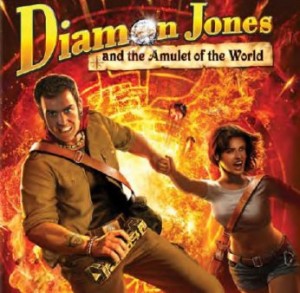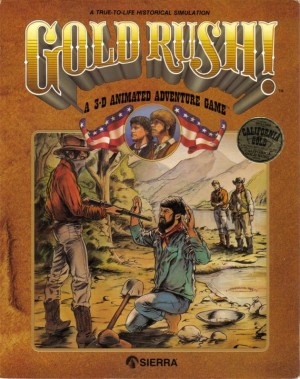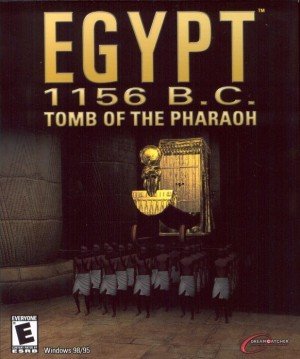Review for Diamon Jones: Amulet of the World page 2
Ah, the blazing sands of Egypt and the crowded streets of Cairo, where the tangy smell of exotic spices mixes with sweat... the long rides on the backs of camels, the tantalizing mirage of an oasis... and the pyramids, the impenetrable tombs of the Pharaohs! What secrets lie hidden in their inner sanctums? What treasures did the ancients bury beneath the stone, behind countless traps and obstacles? Making such a discovery is the dream of every archaeologist, of every desperate adventurer in search of fame and fortune… including one Diamon Jones, an out-of-luck, pennyless treasure seeker who is swamped with debts and has miserably failed to find even the slightest amount of gold during his ill-fated adventures. That is, until one day he stumbles by total fluke upon a clue that may lead him to the greatest treasure of the world.
This, in a nutshell, is the basic premise of Diamon Jones: Amulet of the World. If it sounds familiar to you, it should, because this may well be the most hackneyed premise in the history of adventures. Even the name ‘Diamon Jones’ doesn’t qualify as remotely original. Does the name Indiana Jones ring a bell? The similarity is certainly no coincidence, but that alone isn’t enough to condemn the game, as even the most clichéd idea can be saved by an intelligent plot and engaging gameplay. Unfortunately, this isn’t the case here, as Diamon Jones turns out to be little more than an unimaginative, tedious and remarkably wearisome spoof, whose petty plot and gameplay shortcomings make for a frustrating and forgettable experience.
The game opens some time in the 1930s (naturally) when, after another fruitless day, Diamon Jones walks into his favorite tavern and finds an unusual patron sitting alone and drinking heavily. Being the thoughtful guy that he is, Diamon asks if everything is fine and suddenly the stranger starts blabbering about the Great Pharaoh’s Tomb, a capital discovery for the entire world and the source of an unimaginable treasure. Could this be the chance Diamon has been waiting for? It takes only a cheap bribe to convince the drunken archaeologist to spill the beans about the find, but it turns out Diamon’s ruthless creditor also hankers after the treasure and has every intention of thwarting Jones in his efforts to find it first. Our fearless hero will have to avoid some henchmen and quickly find a way out of the city, toward the secret temple and his long-awaited breakthrough. However, as the story progresses, retrieving the artifact proves to be easier than getting rid of it: the amulet is in fact the key to other dimensions, and once it is taken from its original place, otherwordly terrors and monsters begin threatening mankind and the fate of our world now hangs in the balance.
Diamon Jones’ globe-trotting adventure will take him inside a dangerous sanctuary, into an elegant London district, atop Tibet’s misty mountains and deep within a luxuriant, hazardous jungle. All these exotic locations have been reproduced in a nice cartoonish graphic style enriched by a vivid use of bright, saturated colors. Aside from the notably grainy-looking sky, the pre-rendered backgrounds manage to be visually appealing without being particularly eye-catching. Although the scenes are largely static, I was quite pleased by the number of little details – like the jewels, Persian carpets, cushions and drapes that cram the house of an Egyptian family, or the luscious vegetation of the Tibetan jungle – that enliven every screen. Similarly, the character models are effective and sport a stylized quality that is quite amusing: it is impossible not to laugh at Jones’ nemesis, the small and rotund Samuel Johnson, as well as his impossibly tall and thin henchman. Their facial expressions, displayed in animated portaits at the bottom of the screen during conversation, are equally humorous and quite well done. The rest of the animations, unfortunately, don’t live up to the same standard, with visual shortcuts taken for many actions, and characters seeming to hover above the ground instead of actually walking or running on it.
The same lack of care can be said for the story. The plot is little more than a thin excuse to visit the colorful locations, and the rather banal attempt to tell an adventurous tale is basically an uninspired rip-off of Indiana Jones, Romancing the Stone, The Golden Child and pretty much everything that pops into your mind at the words “Tibet”, “Egypt” and “Pharaoh.” On a gaming level, Diamon Jones bears more than a passing similarity to at least a dozen adventures both past and present, especially Frogwares’ 80 Days, to the point that the two protagonists are almost dressed with the same clothes, scarf included.
Unfortunately, things get even worse when it comes to the writing. Not only does the attempt at humor constantly fall flat, with every joke or pun feeling so out of place that I was more inclined to scowl than laugh, the characters are bland and ordinary, without the slightest sign of personality whatsoever. At best, they are a mismatched cast of stereotypes and mono-dimensional caricatures whose dialogues – clearly intended to be either satirically pompous or ironically understated – can’t help but feel strained and false. Even the hotspot descriptions are cheap, and the fact that multiple clicks often result in different comments by Jones is a wasted opportunity, since the commentary itself is insipid and self-explanatory. Worse still, the subtitles frequently differ from the speech and are full of spelling and grammatical errors due to a poor translation from its original Russian.
It doesn’t help matters that the voice acting is often quite dreadful. Though Jones, Johnson and the scantily-clad archaeologist Mary Ocean, who serves as a romantic interest for our hero, provide acceptable performances, the other supporting characters offer some really ugly accents, often coupled with an odd, drawling prosody. In particular, the voice of Ahmed the bartender is so screeching and pathetically overdone that I wondered what on earth the director was thinking whenever the actor delivered his lines. The music is an equally mixed bag: in their own right, the different tunes associated with the various locations are quite enjoyable, but their brevity and perpetual looping make them unbearable after fifteen minutes. The main theme, with its epic opening and fanfare notes, succeeds a little better, but all in all the music is pretty forgettable and the almost non-existent sound effects make the experience feel even more detached.
Even what should have been a very standard interface leaves something to be desired. Diamon Jones plays from a third-person perspective and everything is controlled with the mouse. The cursor changes accordingly for hotspots, showing the lone interaction available for each object. While quite traditional in nature, the problems start right at the very foundation: the neutral cursor and the animated “picking up” cursor are so similar that if you don’t pay close attention, you may not even notice the change, while the cursor for using an active inventory item is registered by a barely-visible icon brightening. Furthermore, many objects that seemingly can only be examined will suddenly become eligible for taking or using after clicking through all three different descriptions. What’s worse, certain objects become interactive only after a determined action has been accomplished, but without any possibility of knowing in advance.
Any of these issues in isolation might be tolerable, but when combined in the same situation, the game delves into frustration. For example, at the beginning of the second of the game’s six acts, Diamon is inside a tent, somewhere in the desert. With him is a briefcase that he must open (even if it isn’t really clear why should he bother). After he successfully finds the right combination, the case unlocks but the perspective doesn’t change, preventing the player from seeing what’s inside. Hovering over the case, the cursor changes into the unidentified “pick up” option and the player can acquire a rope. However, there are still two more objects inside, and the only way to realize this is by mousing over the case again and waiting to see if the cursor changes. The entire process is cumbersome and unituitive, and breaks down if players fail to meet each and every requirement.
A little later, when Diamon must find his way into the temple, he has to examine a sphinx three times, and only then he can interact with the statue’s eyes, which are two required sapphires. The problem is that the sphinx and the eyes share the same hotspot, and multiple clicking is the only way for Diamon to acknowledge that the eyes are a bit strange. I would certainly never have guessed otherwise, since the two blue stones are so small that I didn’t even realize their color before Diamon revealed it. This problem is quite common throughout the game, and sometimes it felt like I was playing a hidden object game, only without the list of objects to find.
Unfortunately, this isn’t the worst of the gameplay issues, because Diamon Jones is literally crammed with tedious minigames and many of them require good hand-eye coordination and fast reflexes. There is a sequence, for example, right after Diamon leaves Cairo, where he has to pilot a plane, and the player must click and hold the correct mouse button every time the plane tilts right and left, all the while avoiding a bunch of suicidal birds. This particular minigame stands out as the hardest of the bunch, and the inaccurate controls add a good deal of frustration… but not for the last time. The poor controls are a constant: an arcade-like sequence sees Diamon trying to dodge three heavy stone pendulums and the player, with a good sense of timing, must double-click at the right moment in order for Diamon to run and avoid them. However, even this basic action turns out to be incredibly painful, since the character seems to respond with a deadly delay. Prepare yourself also for sequences requiring you to click the left button as fast as you can, others where you must hit the two buttons according to directional arrows that appear on screen, and at the end of the game, even an arcade segment involving shooting and health bars.
The good news (if you can call it that) is that sometimes when you fail, the game automatically restarts at the beginning of the unsuccessful sequence. The bad news is that sometimes – and apparently without reason for the distinction – if you botch a minigame, there is no alternative than to reload a previously saved game. For example, there is a segment where Diamon has to operate seven different levers to rearrange a bunch of tiles, and unless the player solves the minigame on the first try, the game reaches a dead end. What makes this even more annoying is that the instructions for this particular challenge are severely incomplete, as there is no way for the player to know beforehand that left and right-clicks on the levers produce different outcomes. In the end, I had to resort to a walkthrough to see that I was repeatedly failing not for my limited brain capacity but due to one of the game’s many shortcomings.
What’s worse is that these minigames were obviously introduced to cover the lack of actual puzzles, or at least the utterly mundane nature of such obstacles. Let’s see: tile puzzle? Check. Crate puzzle? Check. Jigsaw puzzle, safe combination, lockpicking sequences? Check, check, and check again. Maze? Two of them! While all adventures re-use common puzzle types, of course, every challenge here is so derivative, so straightforward and so predictable that I was rolling my eyes each time I encountered a new one. It’s like the developers worked diligently to litter the game with every adventure stereotype, and did so in such a lacklustre way that player thought isn’t required much at all, since the solution is either obvious or so completely random that old-fashioned trial-and-error is the only available way forward. In the aformentioned briefcase “puzzle” – and mind you, this is only one of many instances where the game simply doesn’t offer the necessary clues – players must press five cylinders in the correct sequence. I scoured the location high and low, but I found no evidence of hints at all, and in the end I simply tried every possible combination. This is bad design, plain and simple. It’s possible that the fault was mine on some occasions, but not nearly as often as they occur in Diamon Jones.
The rest of the puzzles are trivial inventory-based conundrums, as contrived as the plot and characters themselves: there is no inventive twist, no clever use for objects and no creative thinking involved. In some cases, the developers didn’t even try to integrate these puzzles into the story, and as a result they are often ridiculously staged: when Diamon is chased by Johnson’s thugs, for example, he has to retrieve his gun from a box. The problem is that the box is buried under many crates of archaeological artifacts, but instead of throwing the crates aside to get his life-saving gun, Diamon must carefully move each crate so that the small ones are always on top of the large ones until the box is finally cleared.
With far too many issues like this, even at a bargain price through download portals (which is currently the only place to find the game), it’s impossible for me to recommend Diamon Jones: Amulet of the World. Fans of Indiana Jones may like the sound of its premise, but I highly doubt that its contrived plot, abysmal writing, dull characters, annoying mechanics and frustrating minigames will appeal to any experienced adventure gamer. Except for the stylish graphics, this game has almost nothing to distinguish it from a host of other, vastly better games. It’s even very brief, if one doesn’t count the many attempts required to overcome the most frustrating minigames: I was able to finish it in roughly eight hours, at least half of which were devoted to learning how to fly a plane, run through killer blades, shoot bottles, move crates, and… well, you get the idea by now. Ultimately, then, there really isn’t anything here that warrants your attention, nor much that deserved a sequel. It seems that Diamon’s next adventure is already upon us in Eye of the Dragon, however, so here’s hoping he’s learned from his mistakes this time around.



























